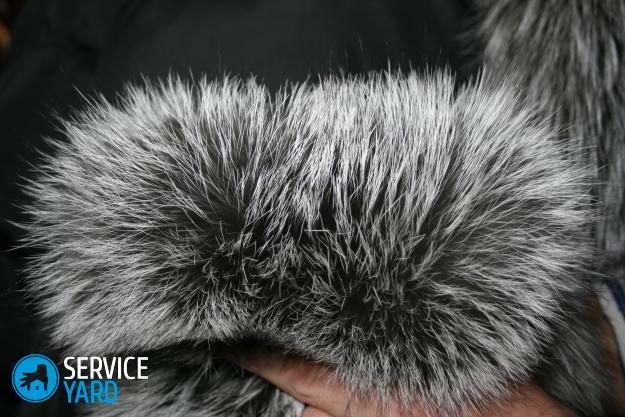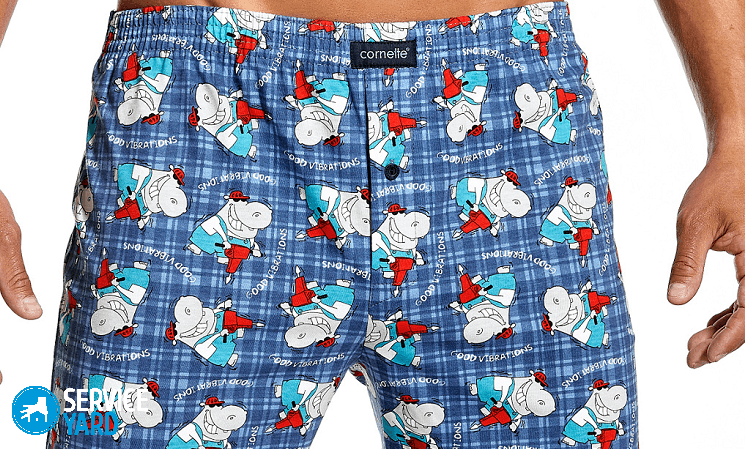Contents:
- How to choose a pan according to the type of its destination?
- Features and technical characteristics of the materials from which the
- frying pans are made. Choose a frying pan based on the features of its
- coating. Important points to look for when choosing a frying pan
The presence of a frying pan in a home kitchen is a regularity, but if several decades ago the housewives coulddispensing with one universal device for frying, modern everyday life is more familiar with the presence of several functional products. Against the backdrop of the rapid expansion of the range of unique products, consumers increasingly have questions about how to choose a grill pan, what are woks, what type of coating is best, what material corresponds to the features of an induction, glass ceramic, electric or gas stove.
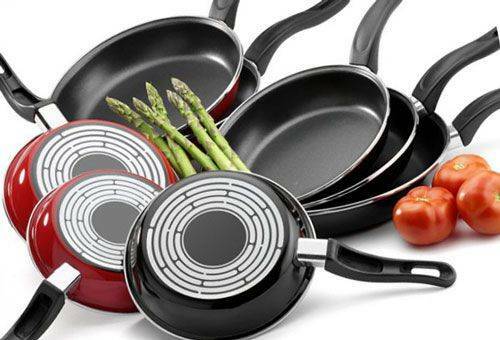
To purchase not only high-quality, but also meet the requirements of all products, you must independently understand all the nuances of the assortment. Correctly selected frying pan will become a pledge of facilitating the work process and obtaining the desired final result.
How to choose a pan according to the type of its destination?
It's best to start the selection process by specifying the goals that will be placed before the frying pan. Specialists distinguish several types of devices according to the type of their destination:
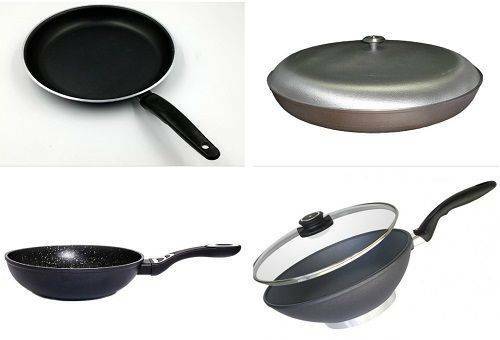
- Classic. A versatile object that is equally suitable for quenching, passaging and frying products. Can be made of a wide variety of materials with or without coating, have additional devices, have different sizes. The main distinctive features are the round shape and the presence of a long handle.
- Brazier. One of the professional types of frying pans, which is traditionally produced from high-strength stainless steel, allows the presence of alloys that provide an even distribution of heat. The bottom, consisting of three layers of materials, allows you to prevent the burning of products or their poor-quality roasting. Can be used on an induction or glass-ceramic plate. It is recommended to give preference to items with small handles, this is convenient when using an oven. Spot welding of handles is better than standard, it prevents strong heating of elements.
- Grill. A distinctive feature is the ribbed bottom, from which characteristic traces remain on the surface of the products. Before choosing a grill pan, you need to compare its features with the type of plate. For glass-ceramic household appliances, it is necessary to select items that exactly match the size and shape of the burners, otherwise the heating will be uneven. When the product is equipped with non-stick coating, you can completely stop using oil. In its absence, the surface will have to be lubricated, but minimally.
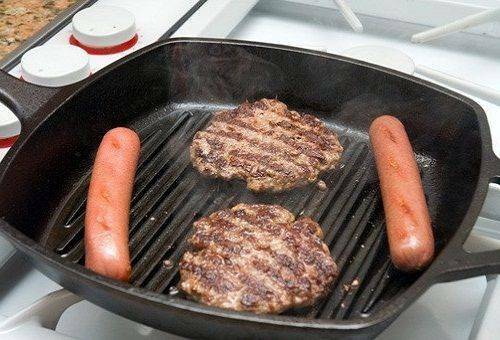
- Stewpot. A hybrid of frying pans and pans, in which you can cook both soup and fried eggs. A good frying pan in this case produces an impressive thickness of the walls and bottom, only in this case the heat will be distributed evenly. Today you can find stash-pan with a temperature scale and liquid level sensors, which greatly simplifies the cooking process and improves the quality of the dishes. If it is supposed to work on an induction or gas stove, it is better to choose a model with a corrugated bottom, protecting the ingredients from burning.
- Wok. A round product with a flat bottom and high sides, greatly expanding in sides, has come to modern kitchens from China. A unique structure provides convenient mixing of ingredients, a uniform distribution of all components. The frying pan is very quickly heated on both the induction and electric stoves, because of the features of the bottom it is not always convenient to use it on a gas burner or a sensitive glass ceramic surface.
- Pancake. Before choosing a pan for pancakes from classic options, it is worth considering the purchase of a profile product. Due to the perfectly flat, flat bottom, low walls and the minimum thickness of metal, pancakes on it will be obtained even for beginners.
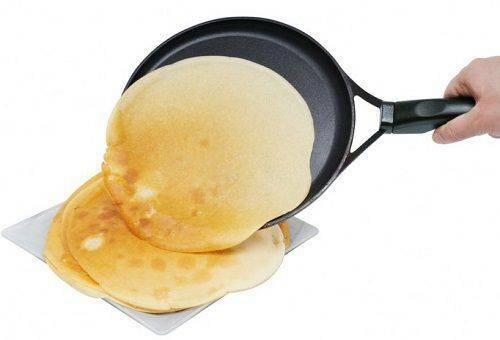
After determining the type of product, you can proceed with the selection of the appropriate material. First you need to determine the base of the device, then - with a suitable coating.
Features and technical characteristics of materials from which frying pans
are made. Even with the advent of innovative alloys, traditional materials have not lost their relevance. Today on the shelves of economic and specialized stores you can find products from the following raw materials:
- Cast-iron frying pans. Despite the specifics, this frying pan should be present in the kitchen of any home. If you use it correctly and take into account the features of the plate, you can at home create real culinary masterpieces. Uniform distribution of heat throughout the product area provides a qualitative study of ingredients that require long-term heating. Cast iron frying pan should be regularly and qualitatively cleaned, then the food will not burn. After treatment, the product must be dried, otherwise it will be covered with rust. To mix ingredients, it is better to use wooden or silicone blades. The only drawback of cast iron is its impressive weight.

Tip: If a cast-iron frying pan, not equipped with a special coating, is used to store products, their appearance and taste will rapidly decline.
- Aluminum products. Cheap and affordable types of tableware that bribes with its light weight and high degree of thermal conductivity. Unfortunately, such a surface strongly smokes, the products on it burn. Given the specifics and cheapness of metal, it is rarely accompanied with non-stick coating. Nutritionists say that aluminum is generally not suitable for frying. Even if you work with it correctly using silicone blades, the product will release substances that adversely affect the digestive system.
- Stainless steel constructions. Practical material is not afraid of chemical, physical and mechanical types of impact. Products that are quickly fried or for a long time sustained in stainless steel cookware do not change their taste, do not get an unpleasant smell. When working with stainless steel products, you can avoid long heating of the device. In just a few seconds, the surface reaches the desired state, even on an induction or electric stove. An empty frying pan should not be kept on fire for too long, it can go to divorce.
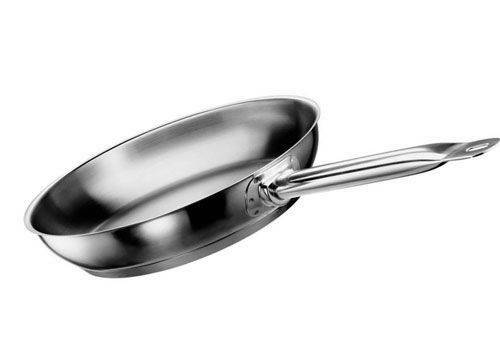
Operation of products of the first and second type is accompanied by a number of nuances, for this reason the housewives increasingly prefer stainless steel frying pans. They are equally effective when cooking on an induction, electric or glass-ceramic plate, they do not deteriorate under the influence of a gas flame. You just need to decide on the appropriate coverage and you can forget about unnecessary troubles.
We choose a frying pan, based on the features of its coating
When evaluating the various dishes, it is necessary to read the label correctly. So fashionable today, marble, ceramic, stone and Teflon pans are most often made of stainless steel or cast iron, with a thin profile non-stick coating. On the one hand, this is a big plus, becauseIt is very difficult to manage with a completely marble or stone product. On the other hand, with a regular operation, the special layer gradually descends, which leads to damage to the instrument.
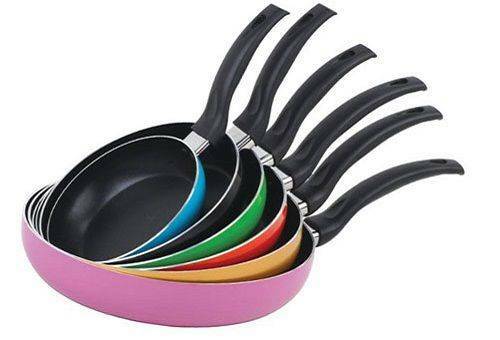
- Teflon. Still remains at the peak of popularity, thanks to its resistance to chemicals and high temperatures. Non-stick properties at a very high level and comparable with the characteristics of cast-iron products. Today Teflon is coated even with aluminum, increasing the productivity of the latter. When cooking frequently at home, it is better to buy a product with a raised bottom, then the risk of food burning will be minimized. Scraped surface is prohibited, even from microscopic cracks will begin to evaporate harmful components. Even with proper care, frying pans with Teflon coating do not serve more than 3-4 years.
- Ceramics. Before choosing a ceramic frying pan made entirely of a composite, it is worthwhile to think several times. Such products do not tolerate direct heating and can crack even on an electric stove. It is better to choose an aluminum product or a stainless steel base. Ceramics quickly and evenly warms up, slowly cools, does not spoil from the effects of chemicals and scratching with sharp instruments. The neutral smell of the material allows you not to worry about the quality of food. For an induction cooker this product is not suitable.
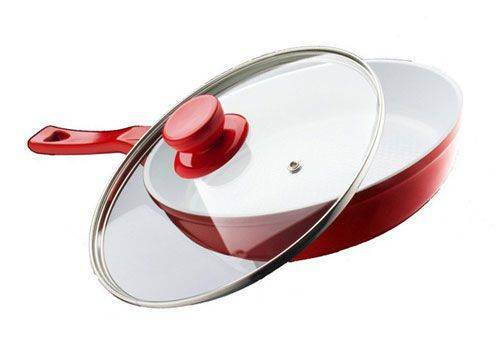
- Granite. With such a durable, reliable and evenly warmed coating can be cooked even on a very small fire. At the same time, the risk of eating poorly fried foods is minimal. The product is very light and easy to use.
- Titanium. Environmentally friendly material, which is not afraid of mechanical impact. In such frying pans you can fry and bake, with the oil you need to add at a minimum. The product with such non-stick coating will last at least a quarter of a century even without special care.
- Enamel. Most often, enamel is used to cover cast iron or stainless steel. It is sensitive to impacts, but this moment can be easily taken into account during operation. But these products do not change the chemical composition of food products and give the dishes an additional attraction.
- Marble. Devices with a marble coating look good and have a strong non-stick property, but this is the end of their features. Not always allowed on induction surfaces.
- Stone. Today, objects with an upper stone layer become more popular. Their main advantage is ecological cleanliness. They do not emit harmful components during cooking, nor during prolonged storage of food in a container. Not suitable for induction cookers.
When choosing a frying pan with marble or stone coating, take extra care. Ethics should indicate the composition of the product - if chemical mixtures are listed in addition to the basic composite material, it is better not to purchase such a product.
Important points to look for when choosing a frying pan
In addition to the described moments, when choosing a frying pan for a house, you need to pay attention to the following nuances:
- Price. It all depends on the base material and the type of coverage, but do not look at products cheaper than 3,000 rubles if you want them to last a long time.
- Manufacturer. In an age of all kinds of fakes, utensils of the lowest quality can be given for a product from a well-known manufacturer, without violating the law. But the country of origin is not easy to forge. Therefore, in the first place, it is better to pay attention to this moment. The most qualitative are the profile goods from Switzerland, Italy, Great Britain, USA and France.
- Before buying it is worth paying attention to which plate the tool is designed for. If a product with a stone or marble coating is allowed on induction cookers, this may indicate the presence of unwanted additives.
After the evaluation of the product you like, you need to hold it in your hands, evaluate the physical and visual parameters. Even the most advanced frying pan will not give pleasure in the cooking process if it causes discomfort.
Read the article on how to choose a good and quality knife

